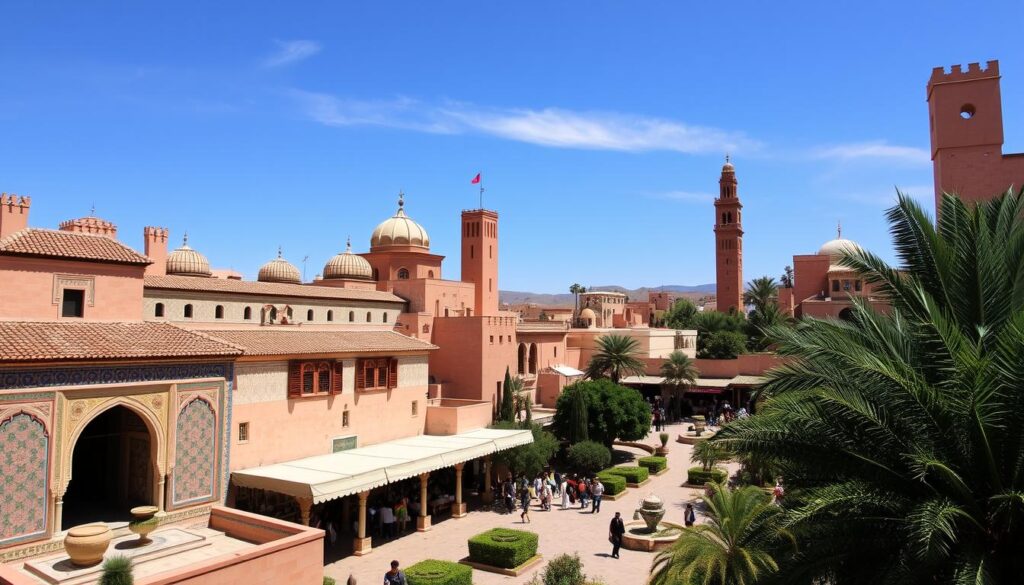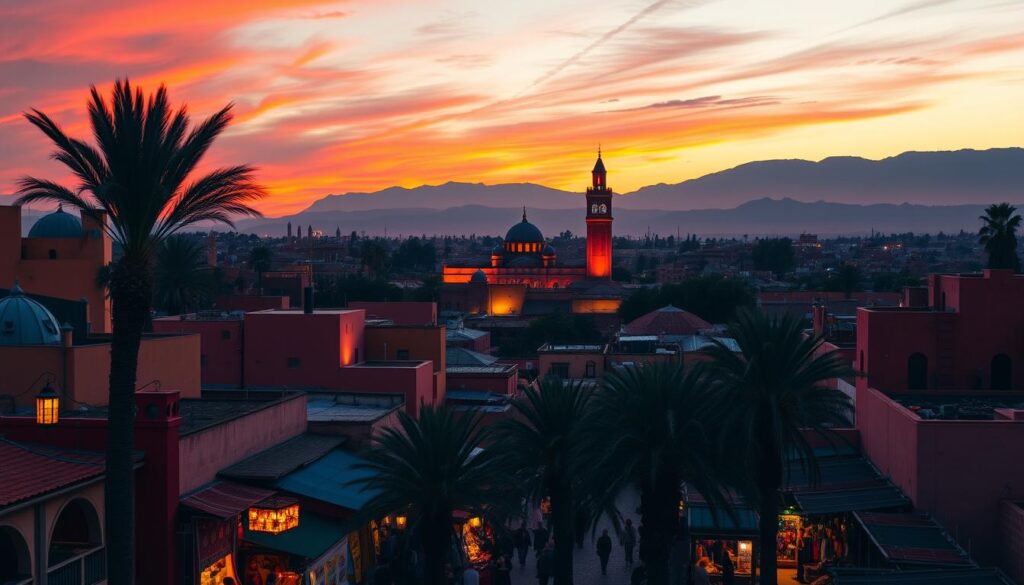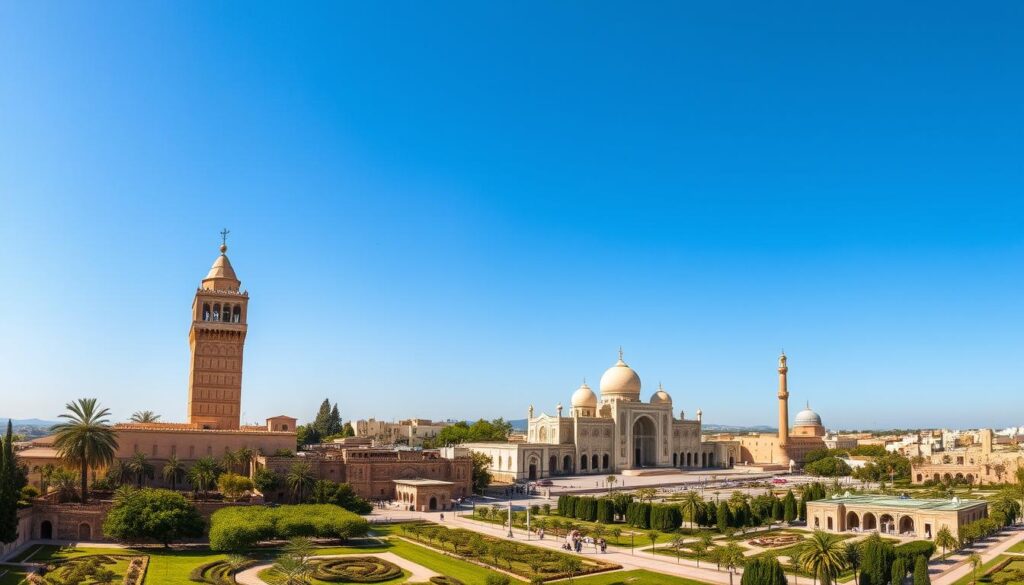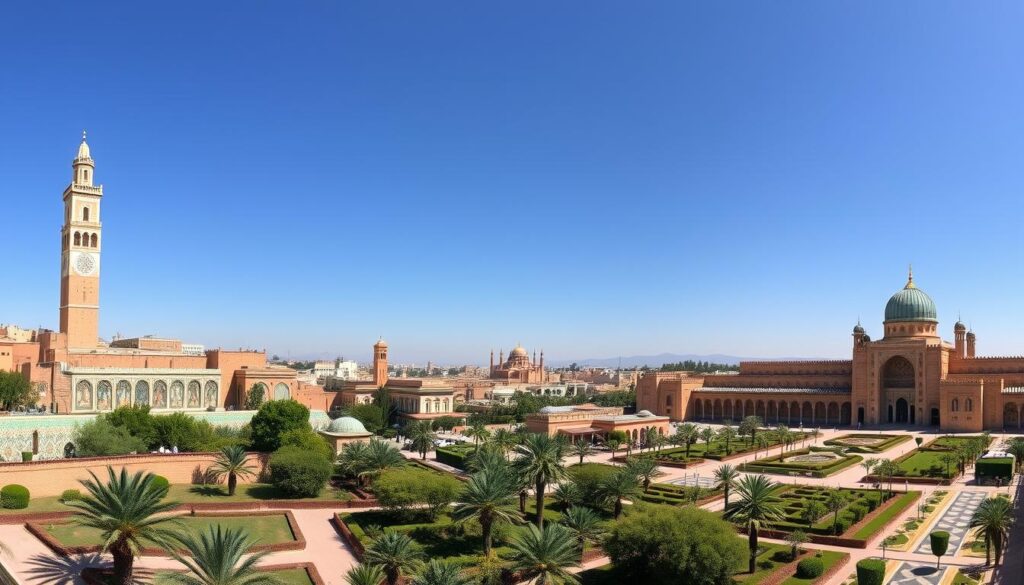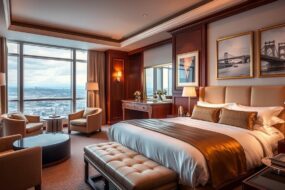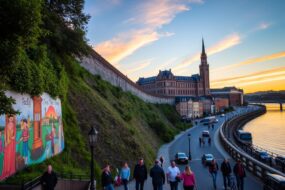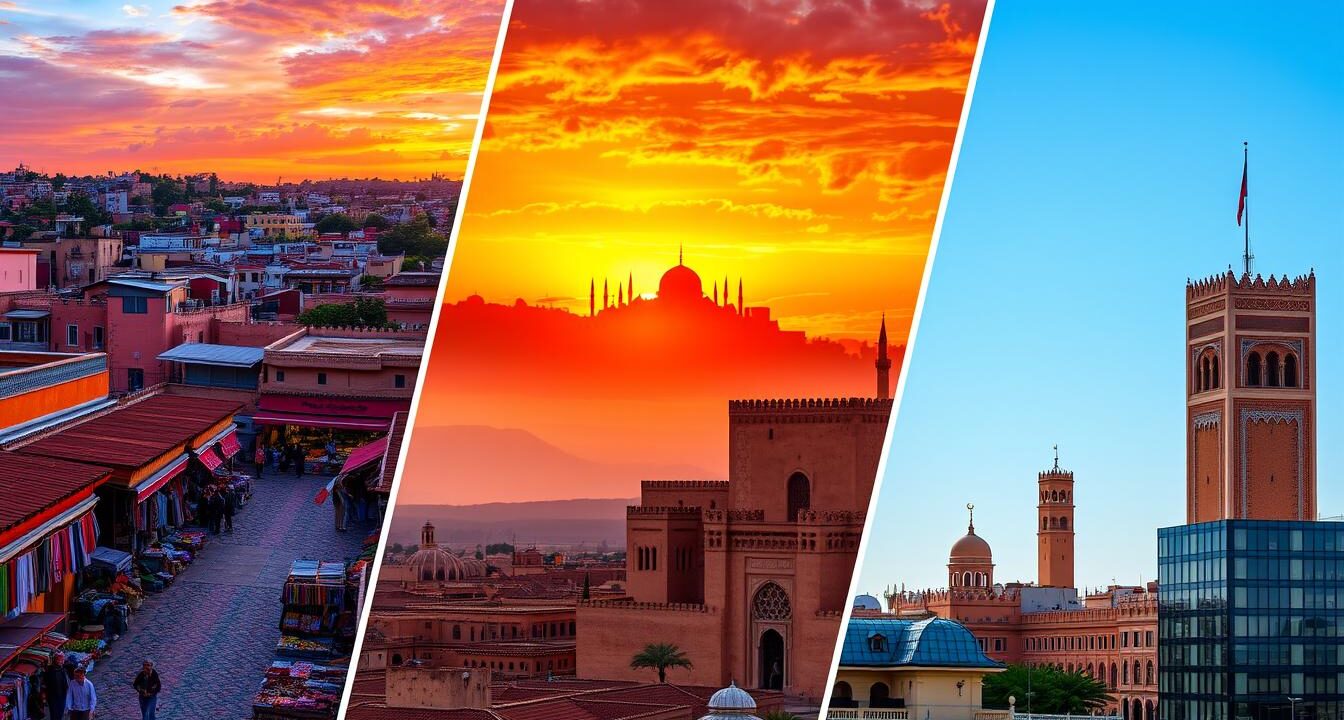
Walking through Fez’s cobblestone streets, I’m hit with the smell of spices and the sound of people everywhere. The city’s history, starting in the 9th century, feels alive around me. The stunning tilework at Al-Qarawiyyin University and the Chouwara tanneries are just the start of Fez’s magic.
Morocco’s imperial cities, like Fez, Marrakech, and Rabat, are key to the country’s story. They were once the power centers of various dynasties. Now, they are lively places where old and new meet, offering a deep dive into Moroccan culture.
Key Takeaways
- Morocco’s imperial cities, Fez, Marrakech, and Rabat, have each served as historical capitals under different dynasties.
- These cities represent the country’s rich cultural heritage, with architectural marvels and UNESCO World Heritage sites.
- Rabat is the current capital of Morocco, while Fez and Marrakech continue to be major tourist destinations.
- Visitors can explore the medinas, tanneries, universities, and other historical landmarks in these imperial cities.
- Morocco offers a unique travel experience, blending ancient and modern elements, for those seeking a cultural adventure.
Introduction to Morocco’s Imperial Heritage
Morocco’s imperial cities of Fez, Marrakech, and Rabat offer a glimpse into the country’s rich Moroccan history and cultural heritage. These cities were capitals of various Imperial legacy dynasties. Each left its mark on architecture and culture.
Fez is called the “spiritual heart of Morocco.” It has the Al-Qarawiyyin University, the world’s oldest university. The city’s medina, a UNESCO site, has narrow alleys and souks. It keeps traditional crafts alive.
Marrakech, the “Red Pearl of Morocco,” is a center of culture and commerce. The Jemaa el-Fnaa square is famous for its snake charmers and food vendors. The city also has stunning palaces and gardens.
Rabat, the modern capital, mixes medieval and modern. The Hassan Tower and Mohammed V Mausoleum are architectural wonders. The Kasbah des Oudaias shows the city’s sea history.
In these cities, you can dive into Morocco’s cultural traditions and artistic legacy. You’ll see traditional crafts, music, and food.
Exploring Morocco’s imperial cities is a journey through history and culture. You’ll see Islamic planning, UNESCO sites, and local life. It’s a chance to see Morocco’s past and its vibrant culture.
The Historical Significance of Imperial Cities in Morocco
Morocco’s imperial cities, like Fez, Marrakech, and Rabat, have greatly shaped the country’s Moroccan history, imperial legacy, and Moorish influences. These cities were key in the rise and fall of dynasties. They were centers of politics, economy, and culture for the Moroccan Empire.
Early Islamic Period and Dynasty Formation
Fez, the oldest city, was founded by Idris I between 789 and 808. It was the capital under many dynasties, including the Marinid and Alaouite. This made Fez a center of Moorish influences and Islamic learning.
Rise and Fall of Various Dynasties
Marrakech, known as the “Red Pearl of Morocco,” was the capital for the Almoravid and Almohad dynasties. It played a big role in the imperial legacy. Rabat became the modern capital, showing Morocco’s changing political and administrative centers.
Cultural Impact Through Centuries
These cities have deeply influenced Moroccan culture. They showcase the country’s architectural, artistic, and culinary traditions. From Fez’s zellij tilework to Marrakech’s markets, the Moroccan history and culture are tied to these cities.
“The imperial cities of Morocco are not merely historical relics, but living embodiments of the nation’s enduring cultural and architectural traditions.”
Fez: The Spiritual Heart of Morocco
Fez, in the heart of Morocco, is a city rich in culture. Founded in the 8th-9th century, it’s Morocco’s spiritual and intellectual hub. It’s home to Al-Qarawiyyin, the world’s oldest university still in operation.
Al-Qarawiyyin University: World’s Oldest Institution
The Al-Qarawiyyin Mosque and University complex dates back to 859 AD. It’s a UNESCO World Heritage site and a key place for learning. For centuries, it has attracted scholars and students from all over, making it the oldest university in the world.
Medieval Medina and Its Landmarks
The Fes el Bali, Fez’s ancient medina, is a UNESCO-protected area. It has over 9,000 winding streets and alleys. Here, you’ll find historical gems like the Bou Inania Madrasa, famous for its beautiful tile work and plaster details.
Traditional Crafts and Artisan Heritage
Fez is known for its long tradition of craftsmanship. Artisans have kept old skills alive in leather tanning, pottery, and metalwork. The Chouara Tannery is a famous spot where you can see how leather is dyed and tanned, offering a unique exotic Moroccan experience.
Fez’s spiritual heart, ancient medinas, and artisan heritage show Morocco’s rich cultural heritage. It’s a true gem among UNESCO World Heritage Sites.
Marrakech: The Red Pearl of Morocco
Marrakech, the “Red City” of Morocco, is a treasure trove of culture. Founded in 1071, it was once the capital of the Almoravid and Almohad dynasties. Its medieval architecture and ancient medinas are a testament to its rich history. Wander through its narrow streets, bustling souks, and historical sites to discover Marrakech’s beauty.
The Jemaa El Fna square is Marrakech’s vibrant heart. It’s a UNESCO-recognized cultural treasure. Here, you’ll see acrobats, storytellers, and snake charmers, taking you back to Morocco’s ancient times.
The Koutoubia Mosque, with its tall minaret, shows the city’s Islamic heritage. The Saadian Tombs, nearby, reveal the opulence of the Saadian dynasty. They showcase Moorish architecture’s beauty.
Marrakech mixes old charm with modern comforts, attracting tourists. Visit the Majorelle Gardens and Menara Gardens for a peaceful escape. These spots contrast the lively souks, offering a unique Moroccan experience.
Exploring Marrakech’s ancient medinas, trying its food, or learning its history is unforgettable. Marrakech offers a journey through Morocco’s medieval architecture and ancient medinas.
“Marrakech is a feast for the senses, a city that captivates the heart and ignites the imagination.” – Tahir Shah, British travel writer
Rabat: From Medieval Glory to Modern Capital
Morocco’s capital, Rabat, has a history going back to the 12th century. This coastal city mixes old and new architecture. It gives visitors a peek into its imperial legacy. The Hassan Tower and Mohammed V Mausoleum are key landmarks, showing Morocco’s building skills.
Hassan Tower and Mohammed V Mausoleum
The Hassan Tower is a 12th-century minaret that’s still unfinished. Its incomplete state adds mystery, making visitors wonder about the original mosque. The Mohammed V Mausoleum, honoring a former king, has a modern design that fits the city’s old charm.
Kasbah des Oudaias: A Fortress by the Sea
The Kasbah des Oudaias is a 12th-century military camp. It’s known for its blue and white buildings and views of the Atlantic Ocean. This place is peaceful and full of history, making it a favorite spot for visitors.
Contemporary Administrative Center
Rabat keeps its old charm but is also Morocco’s government center. It has the Royal Palace and government buildings. This mix of old and new makes Rabat a special place for travelers, showing Morocco’s rich past and modern life.
Architectural Marvels and UNESCO Heritage Sites
Morocco’s imperial cities are filled with architectural wonders and UNESCO World Heritage Sites. These sites highlight the country’s rich medieval architecture and Moorish influences. Places like Fez’s ornate gates and Marrakech’s Koutoubia Mosque show Morocco’s glorious past.
Fez’s historic center, a UNESCO World Heritage Site, takes visitors back in time. Its zellige tilework and stucco work are stunning. The UNESCO-listed Kasbah of Udayas in Rabat and Marrakech’s historic center also showcase Moorish beauty.
“Morocco’s imperial cities are living museums, where the past and present seamlessly intertwine, offering a glimpse into the country’s rich cultural heritage.”
These cities have many more architectural wonders beyond UNESCO sites. The Hassan Tower in Rabat and the Bou Inania Medersa in Fez are just a few examples. They highlight the region’s medieval architecture and Moorish influences.
Exploring Morocco’s cities is a journey through history and culture. Whether in Marrakech’s souks, Fez’s medinas, or Rabat and Meknes’ grand cities, Morocco’s architecture is captivating. It draws travelers from all over the world.
Cultural Traditions and Artistic Legacy
Morocco’s imperial cities are alive with culture, showing off the country’s rich artistic history. In Fez, you’ll see the fine craftsmanship that’s famous worldwide. Marrakech, meanwhile, is known for its music that captures the heart.
These cities in North Africa are a mix of Moroccan culture. They show the beauty of Moroccan traditions.
Traditional Craftsmanship
Fez is the spiritual center of Morocco, famous for its leather and ceramics. Visitors can see artisans at work in the old medina. Marrakech is known for its colorful textiles and woodwork, with souks full of handmade items.
Musical Heritage
Morocco’s cities are filled with music, from Rabat’s Andalusian classical to Marrakech’s Gnawa beats. These sounds are a big part of what makes Morocco special. They attract travelers from everywhere.
Culinary Traditions
The food in Morocco’s cities is also a big part of its culture. In Fez, try the tagines and couscous. Marrakech’s Jemaa El Fna is famous for its street food. Each city offers a unique taste of Morocco’s flavors.
“Morocco is not a country, it’s a dream, a texture, a taste, a place of the mind.”
Islamic Influence on Urban Planning
Morocco’s imperial cities, like Fez, Marrakech, and Rabat, show the strong Islamic influence on urban planning. The medinas (old town quarters) of Fez and Marrakech are UNESCO World Heritage sites. They show how architecture and faith are closely linked.
The layout of these cities separates homes, shops, and mosques. Narrow streets, central mosques, and fountains create a beautiful scene. Fez’s Al-Qarawiyyin University, founded in 859 AD, is the oldest school in the world. It shows the strong academic traditions in these medinas.
Rabat, the capital, mixes Islamic and French colonial planning. Its newer parts blend old traditions with modern styles. This creates a city that honors Morocco’s past while meeting today’s needs.
“The Moorish influences on Moroccan urban planning are evident in the narrow, winding streets, central mosques, and communal fountains that define the character of these historic cities.”
The Islamic architectural principles have made Morocco’s cities culturally and historically important. They are key places to visit for those interested in medieval architecture and ancient medinas.
Tourism and Preservation Efforts
Morocco’s historic cities, like Fez, Marrakech, and Rabat, are famous travel spots and UNESCO World Heritage Sites. The country struggles to keep its culture alive while welcoming tourists.
Conservation Challenges
More visitors mean more pressure on these old cities. Experts work hard to keep places like the Hassan Tower in Rabat and the Koutoubia Mosque in Marrakech safe. They also protect the unique skills and art that make Morocco special.
Sustainable Tourism Initiatives
Morocco is trying to reduce the harm from tourism. They’re working on projects that help the cities and people stay true to their roots. This way, future visitors can still see the real beauty of these places.
Cultural Preservation Programs
Morocco is also saving its cultural treasures. They’re protecting traditional crafts, music, and food. This ensures Moroccan culture stays alive and open to everyone.

